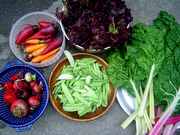

|
| Vegetable Varieties for Gardeners is a citizen science program
|
|
|
|
'Earlivee' Corn |
| |
| Sub-Category: |
Normal (su)
Early Season
Yellow kernel
|
| |
|
| Sub-Category 2: |
| | Description: |
Hybrid, early-season, normal (su), yellow corn with 7-inch ears that are well-filled to the tip with 12 to 14 rows of kernels.
|
| Days To Maturity: |
57
|
| Seed Sources: |
|
| |
| Rating Summary |
| |
Overall: (4.0 Stars)
Taste: (4.5 Stars)
Yield: (2.0 Stars)
Ease/Reliability: (4.0 Stars) |
| |
| Reviews |
| |
Login to share your Review of Earlivee.
Number of Reviews: 2
KEY: O=Overall Rating, T=Taste, Y=Yield, E=Ease
Reviewed on 12/27/2005 by
MATERGIRL
- An intermediate gardener
|
 Overall Overall
 Taste Taste
 Yield Yield
 Ease Ease
|
York, Pennsylvania, United States
Frost Free Season: 123 - 143 days
Soil Texture: Clay
Garden Size: Large - More than 1,600 square feet (40' x 40')
Sun Exposure: More than 8 hours per day
|
| Corn stalks are relatively short. Corn is great tasting, sweet, tender. Worth the try for some really early open-pollinated corn. The only drawbacks: this kind of corn needs to go right from the garden into the pot! Did not keep even overnight for me - the kernals turned starchy. The other thing is that the corn got a lot of smut. I read early corn is more subject to smut and we did get a lot of rain here in southern PA in 2005, so maybe that was also a contributing factor. Smut is a highly prized sort of mushroom in Mexican cuisine, but I never tried it. |
| |
|
Reviewed on 08/21/2005 by
pupster
- An experienced gardener
|
 Overall Overall
 Taste Taste
Yield
 Ease Ease
|
Maine, United States
Frost Free Season: 103 - 123 days
Soil Texture: Clay
Garden Size: Large - More than 1,600 square feet (40' x 40')
Sun Exposure: More than 8 hours per day
|
| A short season corn for areas with cold Springs and early frosts. Flavor is good - if the alternative is no corn in August, and reliability is its winning quality. |
| |
|
|
|
|
Vegetable Varieties for Gardeners is a citizen science program, © 2004-2024, All Rights Reserved
Cornell Garden Based Learning, Cornell University College of Agriculture & Life Sciences, Horticulture Section
|






 VVfG home
VVfG home
 Taste
Taste Ease
Ease